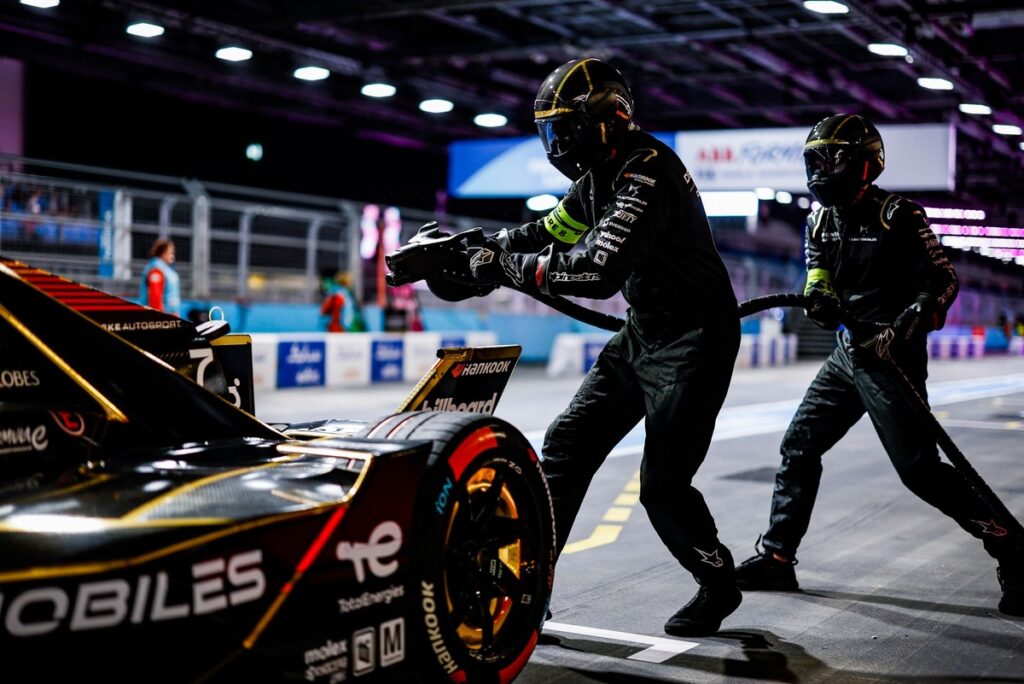Third in the teams’ championship going into London, the DS Penske team is more determined than ever to maintain its position. To do so, it needs to finish the race and score points by getting both cars into the top 10, as it has done several times this season. But in Formula E, no two races are alike, especially at the end of the championship when some drivers have nothing to lose and tend to take more risks.
On Saturday morning, the paddock at ExCel London woke up to overcast skies. At 10am, the cars took to the track for free practice in conditions where grip was still precarious. Although the air temperature was 20C, the asphalt remained tricky, with some areas of low grip and patches of moisture. The specific nature of the track, combining inside and outside sections, further complicated matters: the transitions between the two surfaces created sudden movements that the drivers had to absorb with finesse. As on the previous day, the teams focused on working on the set-up in search of the perfect lap time.
In qualifying, Maximilian Guenther put in a strong performance in Group A, setting the second fastest time and securing his place in the duels. Jean-Eric Vergne, in Group B, also showed some good form, leading the way for more than half of the session. The second part was more complex, and he ultimately missed out on a place in the final qualifying session by four tenths of a second. Later, Guenther lost his duel against Nyck de Vries (Mahindra), and the two DS E-Tense FE25s qualified in sixth with Guenther and 15th with Vergne.
A masterful strategy and well-planned comeback: DS Penske rewarded
DS Automobiles, which has been involved in Formula E since 2015 and has partnered with Penske Autosport since the Gen3 era, is capitalising on its high-level strategic expertise. This first race in London, contested over 37 laps, introduced, as in every double-header, a mandatory Pit Boost which is a 30s stop to recharge up to 3.85kWh when the battery level is between 40% and 60%.
Maximilian Guenther, DS Penske
Photo by: DPPI
This is purely a strategic exercise, as recharging is not technically necessary to see the chequered flag. Therefore, the art of timing this ‘boost’ in the race becomes an essential tactical lever. Vergne got off to an excellent start, gaining four places in the first few corners. However, his team-mate Guenther was stuck behind several drivers and his car was pushed into the wall.
As the only representative of the Franco-American team on the track, Vergne methodically applied his energy strategy. On this winding urban circuit, where every overtaking manoeuvre carries a risk, the Frenchman drew on his experience and precision to move back up through the field. In ninth place, he waited for the right moment to engage his two attack modes and activate his Pit Boost, which he did just before the halfway point of the race.
As the attacks continued and the cars emerged from their power boost phases, in the final third of the race, Vergne was in sixth place thanks to well-executed strategy by the DS Penske engineers. With five laps to go, a second safety car intervention further tightened the gaps, while several drivers, including Vergne, had already activated their final attack mode.
An extra lap was added by the race director, but the positions remained unchanged. Starting from 15th, Vergne made a superb comeback to finish sixth. It was a solid and intelligent performance, typical of the French driver and DS Penske’s surgical approach. This racing science had already enabled him to move up from 18th to third place in the second race of the Berlin E-Prix just two weeks ago.
Sunday will see the final round of the year, DS Penske’s last chance to consolidate its positions in the teams and drivers’ championships.
In this article
Be the first to know and subscribe for real-time news email updates on these topics
Read the full article here

